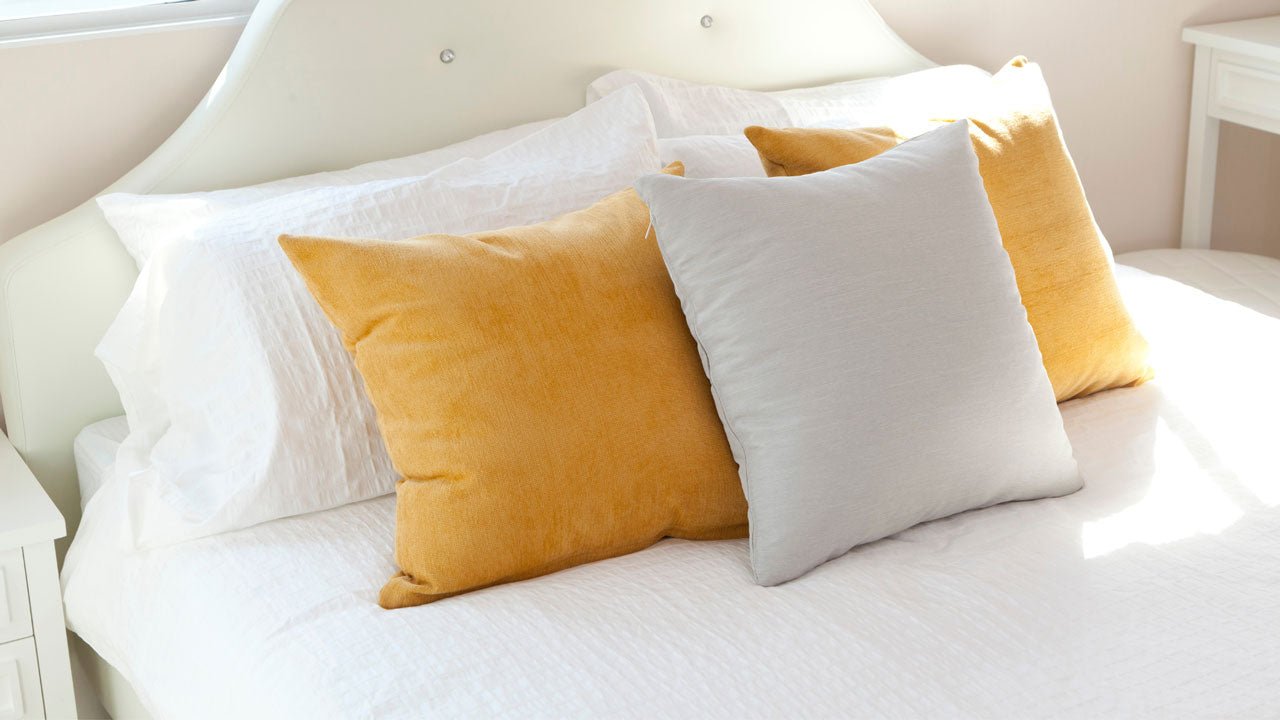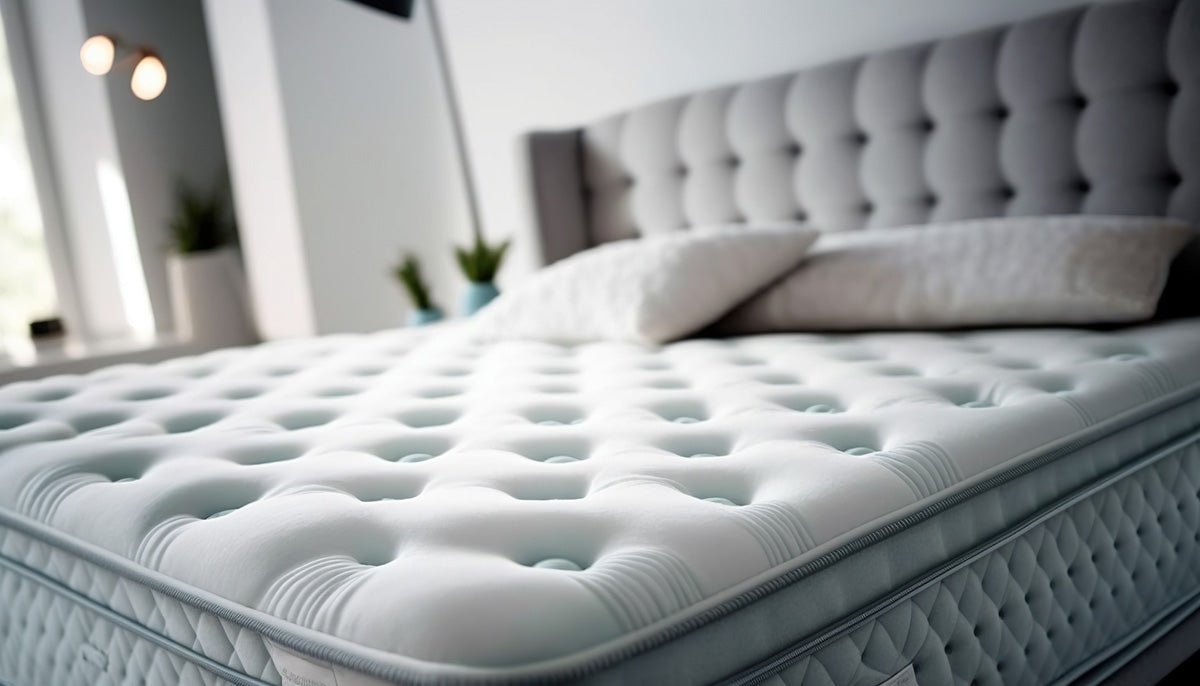After your mattress, choosing the right pillow is probably the most important decision you’ll make when it comes to getting a good night’s sleep. It can be overwhelming, as there are so many brands, materials and firmness levels to choose from.
To help you make the best decision, we've put together this no-nonsense guide to the most popular types of pillows used today.
Whether you're looking for a pillow to help reduce snoring, pillows to help with neck pain, pregnancy pillows or any other type of pillow, we have just what you need at Mattress & Pillow Science.
Pillow type according to filling materials
The filling of the pillow affects its level of support, comfort and heat retention. When choosing a pillow filling, keep in mind whether you prefer your pillows to be soft or firm and whether you tend to get hot at night. Your budget will also play a role in your decision as some materials, like natural down, tend to be more expensive than synthetic fibres.
- Down pillows
Down pillows are filled with the soft, fluffy undercoating of either goose or duck feathers. They provide a soft to medium level of support and are one of the most comfortable pillow types available. Down filling compresses and flattens much more than synthetic fibres, so these pillows require frequent fluffing and reshaping for optimal performance.
- Feather pillows
Feather pillows are filled with the stiffer exterior feathers of either ducks or geese. They offer a medium to firm level of support and are quite resilient, maintaining their shape even after years of use. Feathers also provide excellent insulation, making them suitable for people who tend to get cold at night. However, you'll need to make sure the cover is tightly woven to prevent the feathers from poking through.
- Wool pillows
Wool is a natural material that's highly resilient and durable. It offers a medium level of support, is naturally breathable and can help your body maintain an ideal temperature while you sleep. One of the downsides of wool pillows is that they tend to flatten faster than other materials, so they require regular fluffing to maintain their loft.
- Synthetic fibre pillows
Synthetic fibre pillows are filled with fluffy fibres, most commonly made from polyester. Depending on the specific material and fill density, they offer soft to medium support. It's even possible to buy synthetic down polyester & microfibre pillows if you want the light-as-a-cloud feel for a more affordable price. This is the most common material for kids' pillows as it's easy to care for and doesn't require any special washing instructions.
- Memory foam pillows
Memory foam is a popular filling for pillows, as it offers excellent support for your neck and head. It's highly resilient and contours to the shape of your head and neck when you lie down on it. Memory foam pillows come in a wide range of shapes and sizes, including travel pillows. The only downside is low quality memory foam can run hot, so if you're in a warm climate or tend to feel too warm in bed, you might want to choose a model that's infused with gel or other materials for better heat conductivity.
- Latex pillows
Latex pillows are filled with either natural latex or synthetic rubber foam. They provide a medium to firm level of support and feel similar to memory foam. Unlike memory foam, however, latex is naturally breathable, making it a cooler option if you tend to get hot at night.
- Gel pillows
Gel pillows are usually made from foam infused with a special type of gel that helps to evenly distribute the weight of your head and neck. Some models have a top layer of gel designed to provide extra cooling, making it a great choice if you tend to overheat in bed. These can be great pillows for migraines and headaches, as the cooling gel provides relief while the shape and support of the pillow reduce pressure on your neck and shoulders.
- Copper and graphite-infused foam pillows
Like gel pillows, copper pillows and graphite pillows are designed to keep you cool. The copper and graphite particles act as heat conductors, drawing heat away from your body. Copper is also antimicrobial, helping to reduce allergens and odours for a fresher sleep experience.
- Hybrid pillows
Hybrid pillows are filled with a combination of two or more materials for maximum comfort and support. A popular example is the combination of synthetic fibre and latex, which offers superior neck and head support while still being soft as you sleep. Some hybrid options are adjustable pillows, which include two or more layers of material you can add or remove to adjust the pillow height.
Pillow types according to casing materials
While not as critical to the feel of your pillow, the casing material is also an important factor to consider. Polyester and polyester blends are the most common as they are lightweight and inexpensive. Cotton and bamboo are popular choices for those who prefer natural materials.
Bamboo pillows, in particular, offer superior temperature regulation and moisture-wicking properties, making them ideal for people who tend to get hot or sweaty when they sleep. In addition, bamboo is naturally hypoallergenic, making it a great choice for those with allergies.
Specialist pillows
Most pillows are of standard shape and size, designed to fit regular pillowcases. However, some memory foam and hybrid pillows come in contoured shapes to better cradle your head and neck.
In particular, if you suffer from back or neck pain, there are specialist pillows designed to reduce symptoms and improve your quality of sleep. These chiropractic & orthopaedic pillows are designed to keep your spine in alignment while sleeping, helping to alleviate any associated discomfort. Pillows for neck pain are usually firmer than standard pillows, with a slightly curved shape to provide better neck support.
You can also buy pillows that are specially shaped to provide support during pregnancy. These pillows are typically much larger than regular pillows and provide additional support for the back, belly and hips.
If snoring is an issue for you or your partner, you may want to consider purchasing anti-snore pillows. These are specially designed to keep your head in a slightly elevated position so that the airways stay open to reduce snoring.
No matter which pillow you choose, it's important to make sure you're comfortable and get the right amount of support for healthy sleep. Taking a few moments to research the different types of pillows available will help ensure you get the best one.




Leave a comment
This site is protected by hCaptcha and the hCaptcha Privacy Policy and Terms of Service apply.